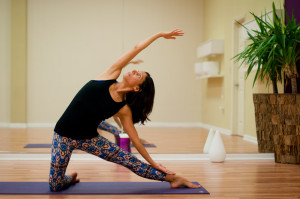Last week I got to take a yoga class with a beautiful friend of mine, a rare treat for a yoga teacher who typically keeps a self practice instead of attending classes. I enjoyed the role of a student – something I consider myself for life – but even more, I enjoyed the sweet release when a few tears came out at the end of class.
I decided to write this post because I know many of you will experience this in your yoga journey. I want to make sure you understand this to be a good thing, not a bad thing.
The main purpose of the yoga practice is the clearing of heaviness and blockages to your health and fulfillment. This is like peeling the layers of an onion to get the flavor and benefits of it, because in the process tears can happen.
In the practice of yoga asana (postures), your physical body changes, but also does your subtle body. This is your energetic, emotional and mental body that manifests in your views and reactions to the world. Tears after practice or during practice are not a sign of weakness or even sadness. Most of the time I don’t know why they show up…but I always know that they are a sign that an unnecessary emotional or mental burden (that had been stored in the body in ways of tension, stiffness and other unhealthy ways) is being released.
The most common areas of the body where these emotions are stored are our shoulders, chest, hamstrings, and for women, the hips. Next time you are in a pose that involves deep engagement of these areas notice what happens in your face, forehead and the inside of the mouth. Pay attention of the tension moving to your face, your shoulders and even your hands. Just watch it and deepen the breath, perhaps mentally repeating “I let go” with each exhale. For me, the two big grief, tension, fear and stress storages have been my chest and hamstrings. I would sometimes feel like I was going to pass out coming out of deep back bends. It felt an almost primal fear – like the fear for my life. This of course was not rational, but the amount of fear deposited in my chest was that powerful…I remember giving myself some cheap self talk like “what is wrong with you?” or “you can do it!” because I thought I could reason my way out of it. But then I let practice, patience and time do its job. Without forcing a release nor fighting it, I got better and better, and when I felt tears coming out I didn’t push them back.
In the main style of yoga I teach, Inner Axis, where mindful breathing is constantly encouraged, this seems to happen even more. This is because ocean breathing (known in yoga as Ujjayi breath) uses the lungs/chest cavity to its highest potential, and the chest is your emotional center. Think about it as the big junk drawer where past hurt, fear and anger goes. A clue of improvement is the release of these old emotions in the form of tears, either during a pose, at the release of a pose or at the end of practice. Sometimes this happens later, in the car or when you make it home. But most people experience this at the time of final relaxation, when the “door is open”. The key here is to welcome your tears.
So what do you do then? My advice is “do nothing”. Let the tears run freely. If you need to go to child’s pose or lay down and cover your face with your towel do that. Just find a posture that makes you feel safe. It is very important that you don’t push the tears down. These stored emotions build up in your body making you a reactive, anxious, angry or sad individual. Sudden outbursts and mindless reactivity are signs that a release is needed. Your body and relationships need this healing. Don’t be ashamed, we’ve all been there. I ensure you your teacher has been there…Tell yourself this is a good thing, let it happen and move on. Don’t try to analyze it. This is not a matter of the mind or the ego. This is a matter of the heart and the spirit and they are infinitely wise – you don’t have to understand it. Just surrender.
So if you have felt this already Congratulations! Your practice is bearing fruits. And if you are not there yet, don’t worry, your are not doing anything wrong. Just be aware of this possibility and when it shows up don’t push it down. Let go of what no longer serves you and your yoga will be more than a physical routine, it will be an awakening.
May the tears on your mat be welcomed by your willingness to offer an open-hearted surrender,
Namaste

